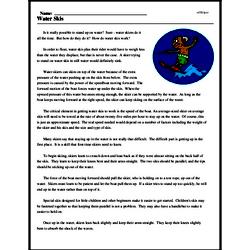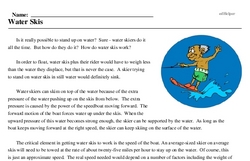Water Skis
Is it really possible to stand up on water? Sure - water skiers do it all the time. But how do they do it? How do water skis work?
In order to float, water skis plus their rider would have to weigh less than the water they displace, but that is never the case. A skier trying to stand on water skis in still water would definitely sink.
Water skiers can skim on top of the water because of the extra pressure of the water pushing up on the skis from below. The extra pressure is caused by the power of the speedboat moving forward. The forward motion of the boat forces water up under the skis. When the upward pressure of this water becomes strong enough, the skier can be supported by the water. As long as the boat keeps moving forward at the right speed, the skier can keep skiing on the surface of the water.
The critical element in getting water skis to work is the speed of the boat. An average-sized skier on average skis will need to be towed at the rate of about twenty-five miles per hour to stay up on the water. Of course, this is just an approximate speed. The real speed needed would depend on a number of factors including the weight of the skier and his skis and the size and type of skis.




